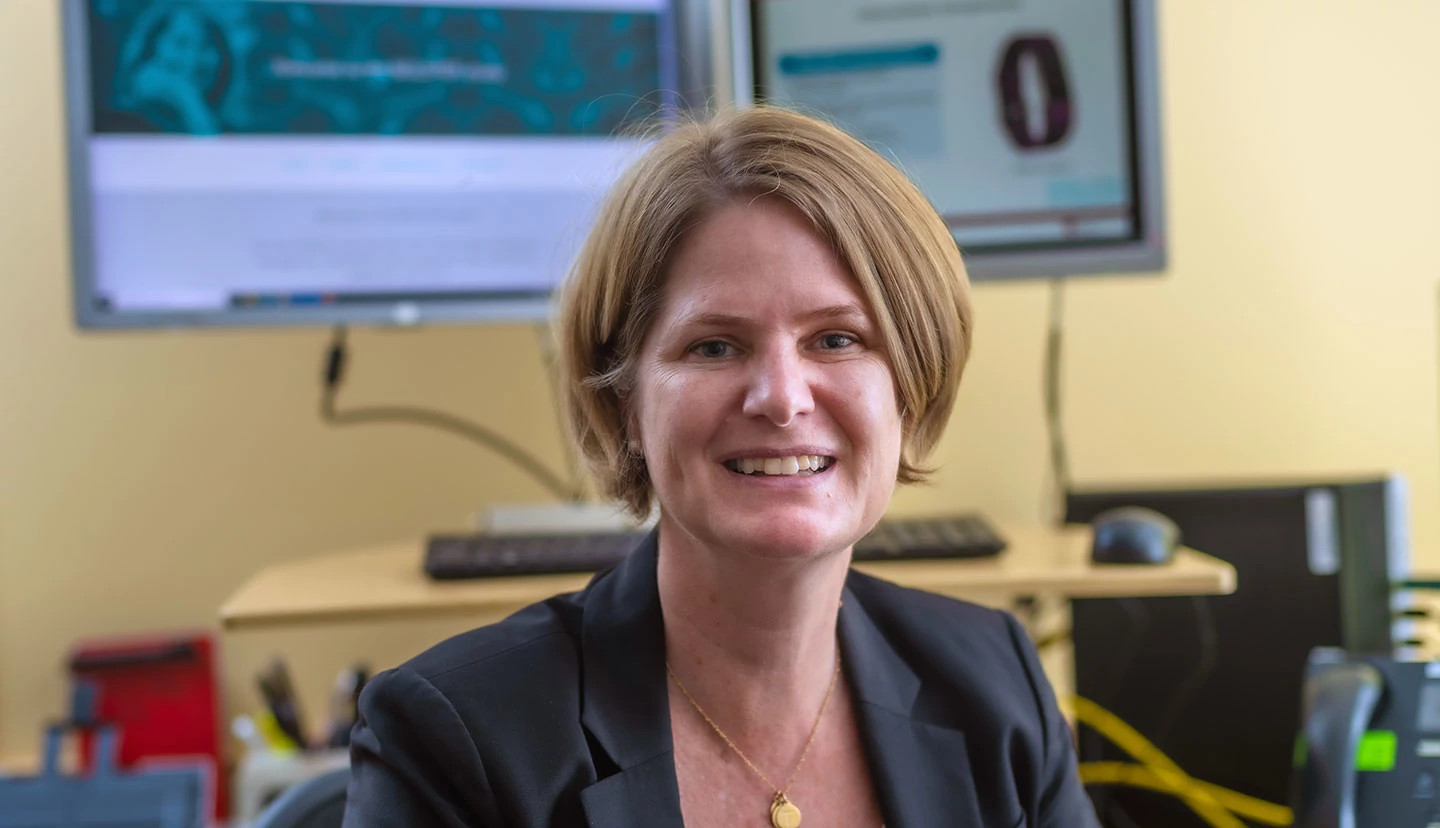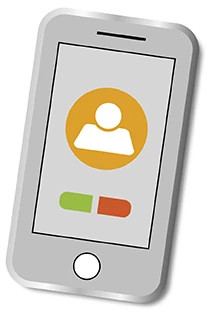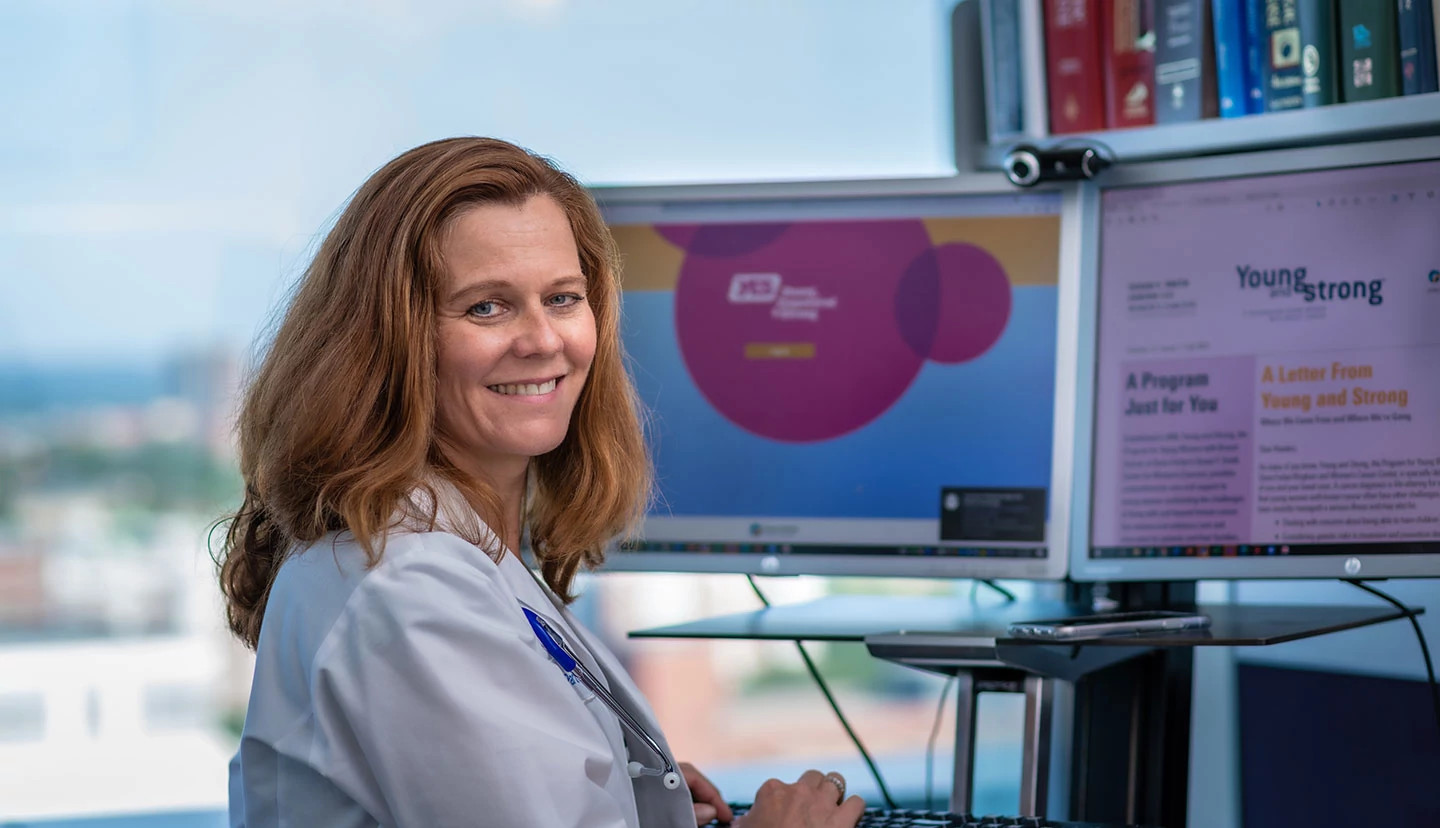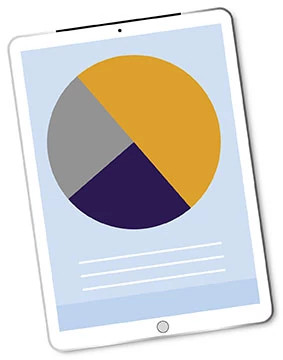
Online Tools Keep Care and Support on Target
December 03, 2021
Gynecologic Cancer
Cancer Genetics
Breast Cancer
By Anna Fiorentino
An ovarian cancer survivor in a clinical trial at Dana-Farber went from using a cane to walking freely – during the pandemic, no less. "It was amazing to see how much better many women felt with relatively modest increases in physical activity," says Alexi Wright, MD, MPH, principal investigator and director of Gynecologic Oncology Outcomes Research at Dana-Farber. "Other women felt like the study helped them begin to trust their bodies again – that muscle pain signified strength rather than disease recurrence."
Wright's initial pilot study, Stepping Into Survivorship, used a Fitbit activity monitor paired with a game to study the effect of exercise on outcomes, and adds to growing evidence that digital tools and online data collection can accelerate research. Wright and her colleagues are now studying this in a randomized trial called Step Into Support for Endurance and Strength (SISTERS). Dr. Wright's study is timely. It comes at a time when the pandemic has emphasized the importance of digital data collection and enrollment, and remote delivery of tools to facilitate clinical trials.

According to the Journal of the American Medical Association, remote patient interactions across the country increased dramatically in the early months of the COVID-19 pandemic – jumping from 9% just before the pandemic hit in January 2020 to 58% in May 2020. Cancer care and survivorship was no exception.
"Many people didn't even know the word Zoom before the pandemic," says Ann Partridge, MD, MPH, founder and director of the Susan F. Smith Center's Program for Young Adults with Breast Cancer. "And in the pandemic, all of our research related to young adults with breast cancer that had been taking place via mail transitioned to electronic surveying."
The key to making research progress in the early days of COVID was a willingness to pivot and adapt. "When the pandemic first started, we knew so little about how COVID-19 was transmitted, how to treat it, who would survive," says Dr. Wright. "It's hard to imagine now because we've come so far, but at that time every human interaction seemed risky, particularly at hospitals and medical centers."
Patients, particularly those who were immunocompromised, needed an alternative to an office visit or a healthcare provider entering their home. "They worried that having someone into their home increased their risk of contracting COVID-19 – and it may have," says Dr. Wright. "We found that patients and their caregivers were most interested in online interventions – particularly an intervention that used telehealth to help patients manage their symptoms when they were transitioning home from the hospital."
As the online research experiment proved successful, a new standard is now being set for the use of digital technology. At Dana-Farber, Dr. Wright, Dr. Partridge, and Huma Rana, MD, MPH, clinical director of Cancer Genetics and Prevention, are helping pave the way.
Online Exercise Tools for Ovarian Cancer Survivors
Patients with gynecologic cancer diagnoses were able to enroll in Dr. Wright's Stepping Into Survivorship study, even while hospitals limited capacity, activities moved outdoors, and people moved their workouts from the gym to the home treadmill.

Dr. Wright knew that patients with ovarian cancer could become deconditioned to their disease while undergoing intense treatment, including surgery and chemotherapy. According to previous research, ovarian cancer survivors are three times more likely to experience lower-body functional limitations with survivors of other cancers, and as a result half of ovarian cancer survivors become sedentary, and 25% become inactive. While evidence had shown that increasing physical activity could reduce the risk of cancer recurrence and mortality, reduce symptoms, and improve physical functioning and mental health, Wright was able to test physical activity interventions specifically in sedentary or older ovarian cancer survivors.
Participants in Dr. Wright's study selected a partner and each member received a Fitbit, and set goals to increase their steps. Each week, teams received points based on progress toward their activity goals. The points had no monetary value, but many participants found them motivating because of the powerful principle of loss aversion – the concept that losing things is more salient than gaining things. Focusing on team-based activity also provided increased social support for patients transitioning away from treatment.
"Many women report that one of the toughest times is right after treatment ends," says Dr. Wright. "Everyone expects them to be better, but many women are still exhausted, scared about the disease recurring, and may feel alone in their experience."
Preliminary results of the study show, however, that their health still improved in the pandemic.
New Tools to Overcome PARP Inhibitor Fatigue
Dr. Wright and colleagues from outside of Dana-Farber, psychologists Hanneke Poort, PhD, and Joanna Arch, PhD, also made progress last year in a clinical trial for patients with ovarian cancer who reported fatigue while being treated with PARP inhibitors, a class of drugs that have revolutionized treatment for patients with ovarian cancer. Her multi-site clinical trial called REVITALIZE provides support, knowledge, and skills to patients to reduce fatigue, psychological distress, and fear of cancer recurrence. Before long, patients in the trial like Karen Maloney saw daily fatigue disappear.
"The one-on-one sessions were very helpful in giving me new perspectives on my fatigue and new ways to lessen its grip on me," Maloney says. "Learning new attitudes and skills to manage fatigue completely improved my quality of life."
Maloney is among nearly 70% of women who experience fatigue while taking PARP inhibitors. "And 10-20% of those will stop the drugs early because of side effects," says Dr Wright. "We're trying to help women continue on these life-saving medications by tackling some of the worst side effects to make them more tolerable." Although the study is ongoing, several patients have noted to investigators that Acceptance and Commitment Therapy (ACT) strategies have reduced their fatigue and helped them to realign their activities with what matters most to them.
By leveraging digital tools for exercise during the COVID outbreak, Dr. Wright is closer to potentially dramatically changing the treatment landscape for patients with an advanced form of the disease. With positive preliminary results, she and her colleagues are performing a pilot randomized trial to see whether participants' fatigue is significantly reduced by the intervention.

Online Support for Breast Cancer Patients
When the COVID lockdown started, Dr. Partridge had been on the verge of launching Young, Empowered, & Strong (YES), a five-year study using a web-based portal to track the progress of young, newly diagnosed or metastatic breast cancer patients, and to help them manage minor physical complaints and psychosocial concerns.

"Unlike a lot of people who had to just shut their research down, we were able to hit the ground running because we were already planning to go virtual," says Dr. Partridge.
Dr. Partridge had planned to recruit patients during visits in the clinic, but that went remote, too, after the pandemic started. Once the online recruitment and consent process was in place, Dr. Partridge launched the trial in September 2020 and the mostly online study was an instant success. Designed for access by smartphone, tablet, or laptop/desktop, the portal allows patients to monitor the frequency and degree of variation in cancer-related issues by taking online surveys and assessments, and sharing self-management progress, resources, and other research opportunities all in one place.
Based on their answers, each participant automatically receives helpful digitized information from Dr. Partridge's Young and Strong Program, and other resources. In the comfort of their own homes, YES provides patients dealing with the isolation of cancer – in the height of isolation of the pandemic, no less – opportunities to journal online and to form a community in chat rooms to help them cope with their new normal. The online community is starting to take off, and enrollment and survey participation is up, supported by the collection of tumor and blood specimens. Meanwhile, the overall Young and Strong Program that supports the YES portal, in some cases saw enrollment double, virtual support grew, and webinars were well attended.
While clinical data on the acute effects of cancer treatments has been widely circulated, through YES Dr. Partridge is able to track less severe symptoms of young patients, as well as support self-management and survivorship, health behaviors, psychosocial concerns, and informational needs throughout their care.
"It's great to be able to avoid coming into the clinic when you're a survivor looking for supportive care," says Dr. Partridge, adding that for the right kind of research going digital is "way more efficient." Each patient's progress is automatically computed into the portal, resulting in less paperwork for the study team. Next, Dr. Partridge plans to launch a similar multicenter online YES portal study for survivors of breast cancer within three years of diagnosis.
Video and Chatbot Patient Education

Dr. Rana is leading a two-armed, two-year study called OPTimizing Treatment Focused Genetic Testing IN Cancer (OPT-IN), to examine the impact of education for germline genetic testing education. The trial is looking to pre-test video versus chatbot education to help researchers gain a better understanding of patient preferences.
After successfully accruing patients throughout the pandemic, the study's first arm focused on breast and ovarian cancer patients, while the second arm is open to any patient with any type of stage 3 or 4 cancer. "Patients in both arms of the trial were able to participate remotely from their homes, so it was a win for patient-centered care," Dr. Rana says.
Virtual Visits for Genetic Counseling
Patients were able to access genetic counseling and testing through telemedicine and videoconferencing. Often, patient specimens for genetic testing were obtained through at-home saliva tests sent through the mail. This remote model resulted in 20% growth in the number of cancer genetics patients evaluated by care providers in Dana-Farber's Center for Cancer Genetics and Prevention.
"Patients found it easier to be able to join remotely without having to travel into Dana-Farber," says Dr. Rana. "Our patients tell us they are really happy to receive their care via telehealth or videoconferencing."
And, importantly, she says, improving access to timely genetic testing is a key factor in achieving better outcomes for patients. Dr. Rana expects discussions to continue around ways researchers and genetics providers can better care for patients and high-risk families, including remotely.